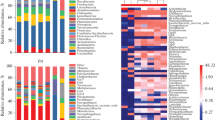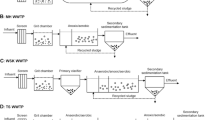Abstract
In this study, we investigated during 400 days the microbial community variations as observed from 16S DNA gene DGGE banding patterns from an aerobic granular sludge pilot plant as well as the from a full-scale activated sludge treatment plant in Epe, the Netherlands. Both plants obtained the same wastewater and had the same relative hydraulic variations and run stable over time. For the total bacterial population, a similarity analysis was conducted showing that the community composition of both sludge types was very dissimilar. Despite this difference, general bacterial population of both systems had on average comparable species richness, entropy, and evenness, suggesting that different bacteria were sharing the same functionality. Moreover, multi-dimensional scaling analysis revealed that the microbial populations of the flocculent sludge system moved closely around the initial population, whereas the bacterial population in the aerobic granular sludge moved away from its initial population representing a permanent change. In addition, the ammonium-oxidizing community of both sludge systems was studied in detail showing more unevenness than the general bacterial community. Nitrosomonas was the dominant AOB in flocculent sludge, whereas in granular sludge, Nitrosomonas and Nitrosospira were present in equal amounts. A correlation analysis of process data and microbial data from DGGE gels showed that the microbial diversity shift in ammonium-oxidizing bacteria clearly correlated with fluctuations in temperature.








Similar content being viewed by others

References
Ayala-Del-Río HL, Callister SJ, Criddle CS, Tiedje JM (2004) Correspondence between community structure and function during succession in phenol- and phenol-plus-trichloroethene-fed sequencing batch reactors. Appl Environ Microbiol 70(8):4950–4960
Bassin JP, Pronk M, Muyzer G, Kleerebezem R, Dezotti M, van Loosdrecht MCM (2011) Effect of elevated salt concentrations on the aerobic granular sludge process: linking microbial activity with microbial community structure. Appl Environ Microbiol 77(22):7942–7953
Bell T, Newman JA, Silverman BW, Turner SL, Lilley AK (2005) The contribution of species richness and composition to bacterial services. Nature 436(7054):1157–1160
Buzas MA, Hayek L-AC (2005) On richness and evenness within and between communities. Paleobiology 31(2):199–220
Cai-Yun W, Heleen DW, Ludo D, Chris T, Jun-Bin L, Li-Nan H (2011) Biodiversity and population dynamics of microorganisms in a full-scale membrane bioreactor for municipal wastewater treatment. Water Res 45(1):1129–1138
Cardinale BJ, Palmer MA, Collins SL (2002) Species diversity enhances ecosystem functioning through interspecific facilitation. Nature 415(6870):426–429
Carrero-Colon M, Nakatsu CH, Konopka A (2006) Microbial community dynamics in nutrient-pulsed chemostats. FEMS Microbiol Ecol 57(1):1–8
Chapin FS, Carpenter SR, Kofinas GP, Folke C, Abel N, Clark WC, Olsson P, Smith DMS, Walker B, Young OR, Berkes F, Biggs R, Grove JM, Naylor RL, Pinkerton E, Steffen W, Swanson FJ (2010) Ecosystem stewardship: sustainability strategies for a rapidly changing planet. Trends Ecol Evol 25(4):241–249
Curtis TP, Sloan WT (2006) Towards the design of diversity: stochastic models for community assembly in wastewater treatment plants. Water Sci Technol 54(1):227–236
de Bruin LM, de Kreuk MK, van der Roest HF, Uijterlinde C, van Loosdrecht MCM (2004) Aerobic granular sludge technology: an alternative to activated sludge? Water Sci Technol 49(11–12):1–7
de Kreuk MK, van Loosdrecht MCM (2004) Selection of slow growing organisms as a means for improving aerobic granular sludge stability. Water Sci Technol 49(11–12, Biofilm Systems V):9–17
Ebrahimi S, Gabus S, Rohrbach-Brandt E, Hosseini M, Rossi P, Maillard J, Holliger C (2010) Performance and microbial community composition dynamics of aerobic granular sludge from sequencing batch bubble column reactors operated at 20, 30 and 35 °C. Appl Environ Microbiol 87(4):1555–1568
Egli K, Langer C, Siegrist HR, Zehnder AJB, Wagner M, van der Meer JR (2003) Community analysis of ammonia and nitrite oxidizers during start-up of nitritation reactors. Appl Environ Microbiol 69(6):3213–3222
European-Water-Framework-Directive (2000) Directive 2000/60/EC of the European Parliament and of the Council of 23 October 2000 establishing a framework for community action in the field of water policy. 1–73
Falk MW, Song KG, Matiasek MG, Wuertz S (2009) Microbial community dynamics in replicate membrane bioreactors—natural reproducible fluctuations. Water Res 43(3):842–852
Fernandez A, Huang SY, Seston S, Xing J, Hickey R, Criddle C, Tiedje J (1999) How stable is stable? Function versus community composition. Appl Environ Microbiol 65(8):3697–3704
Gujer W (1977) Design of a nitrifying activated sludge process with the aid of dynamic simulation. Prog Water Technol 9(2):323–336
Henze M, van Loosdrecht MCM, Ekama GA, Brdjanovic D (2008) Biological wastewater treatment: principles, modelling and design. IWA Publishing, ISBN: 9781843391883
Hornek R, Pommerening-Roser A, Koops HP, Farnleitner AH, Kreuzinger N, Kirschner A, Mach RL (2006) Primers containing universal bases reduce multiple amoA gene specific DGGE band patterns when analysing the diversity of beta-ammonia oxidizers in the environment. J Microbiol Meth 66(1):147–155
Huws SA, McBain AJ, Gilbert P (2005) Protozoan grazing and its impact upon population dynamics in biofilm communities. J Appl Microbiol 98:238–244
Jiang Y, Marang L, Kleerebezem R, Muyzer G, van Loosdrecht MCM (2011) Polyhydroxybutyrate production from lactate using a mixed microbial culture. Biotechnol Bioeng 108(9):2022–2035
Lee N, Jansen JL, Aspegren H, Henze M, Nielsen PH, Wagner M (2002) Population dynamics in wastewater treatment plants with enhanced biological phosphorus removal operated with and without nitrogen removal. Water Sci Technol 46(1–2):163–170
Legendre L, Legendre P (1979) Numerical ecology, developments in environmental modelling. Elsevier, Amsterdam
Levine JM, HilleRisLambers J (2009) The importance of niches for the maintenance of species diversity. Nature 461(7261):254–257, U130
Li AJ, Yang SF, Li XY, Gu JD (2008) Microbial population dynamics during aerobic sludge granulation at different organic loading rates. Water Res 42(13):3552–3560
Lipson DA, Blair M, Barron-Gafford G, Grieve K, Murthy R (2006) Relationships between microbial community structure and soil processes under elevated atmospheric carbon dioxide. Microb Ecol 51(3):302–314
Manefield M, Whiteley AS, Griffiths RI, Bailey MJ (2002) RNA stable isotope probing, a novel means of linking microbial community function to phylogeny. Appl Environ Microbiol 68(11):5367–5373
McCann KS (2000) The diversity–stability debate. Nature 405(6783):228–233
McGuinness LM, Salganik M, Vega L, Pickering KD, Kerkhof LJ (2006) Replicability of bacterial communities in denitrifying bioreactors as measured by PCR/T-RFLP analysis. Environ Sci Technol 40(2):509–515
Müller AK, Westergaard K, Christensen S, Sørensen SJ (2000) The diversity and function of soil microbial communities exposed to different disturbances. Microb Ecol 44(1):49–58
Muyzer G, Smalla K (1998) Application of denaturing gradient gel electrophoresis (DGGE) and temperature gradient gel electrophoresis (TGGE) in microbial ecology. Antonie Van Leeuwenhoek 73(1):127–141
Naeem S (2009) Ecology: Gini in the bottle. Nature 458(7238):579–580
Naeem S, Li SB (1997) Biodiversity enhances ecosystem reliability. Nature 390(6659):507–509
Nicolella C, van Loosdrecht MCM, Heijnen SJ (2000) Particle-based biofilm reactor technology. Trends Biotechnol 18(7):312–320
Park HD, Regan JM, Noguera DR (2002) Molecular analysis of ammonia-oxidizing bacterial populations in aerated-anoxic orbal processes. Water Sci Technol 46:273–280
Pholchan MK, Baptista JD, Davenport RJ, Curtis TP (2010) Systematic study of the effect of operating variables on reactor performance and microbial diversity in laboratory-scale activated sludge reactors. Water Res 44(5):1341–1352
Picioreanu C, Van Loosdrecht MCM, Heijnen JJ (2000) Effect of diffusive and convective substrate transport on biofilm structure formation: a two-dimensional modeling study. Biotechnol Bioeng 72(2):205–218
Pielou EC (1981) The usefulness of ecological models: a stock taking. Q Rev Biol 55:17–31
Rotthauwe JH, Witzel KP, Liesack W (1997) The ammonia monooxygenase structural gene amoA as a functional marker: molecular fine-scale analysis of natural ammonia-oxidizing populations. Appl Environ Microbiol 63(12):4704–4712
Rowan AK, Snape JR, Fearnside D, Barer MR, Curtis TP, Head IM (2003) Composition and diversity of ammonia-oxidising bacterial communities in wastewater treatment reactors of different design treating identical wastewater. FEMS Microbiol Ecol 43(2):195–206
Stephen JR, McCaig AE, Smith Z, Prosser JI, Embley TM (1996) Molecular diversity of soil and marine 16S rRNA gene sequences related to beta-subgroup ammonia oxidizing bacteria. Appl Environ Microbiol 62:4147–4154
Stirling G, Wilsey B (2001) Empirical relationships between species richness, evenness, and proportional diversity. Am Nat 158(3):286–299
Temudo MF, Muyzer G, Kleerebezem R, van Loosdrecht MCM (2008) Diversity of microbial communities in open mixed culture fermentations: impact of the pH and carbon source. Appl Microbiol Biotechnol 80:1121–1130
Tilman D, Knops J, Wedin D, Reich P, Ritchie M, Siemann E (1997) The influence of functional diversity and composition on ecosystem processes. Science 277(5330):1300–1302
van Nostrand JD, Wu L, Wu WM, Huang Z, Gentry TJ, Deng Y, Carley J, Carroll S, He Z, Gu B, Luo J, Criddle CS, Watson DB, Jardine PM, Marsh TL, Tiedje JM, Hazen TC, Zhou J (2011) Erratum: Dynamics of microbial community composition and function during in situ bioremediation of a uranium-contaminated aquifer. Appl Environ Microbiol 77(14):5063
Wells GF, Park H, Yeung C, Eggleston B, Christopher AF, Criddle CS (2009) Ammonia-oxidizing communities in a highly aerated full-scale activated sludge bioreactor: betaproteobacterial dynamics and low relative abundance of Crenarchaea. Environ Microbiol 11(9):2310–232823
Wells GF, Park H, Eggleston B, Cooper A, Criddle FC (2011) Fine-scale bacterial community dynamics and the taxa–time relationship within a full-scale activated sludge bioreactor. Water Res 45:5476–5488
Wilsey BJ, Potvin C (2000) Biodiversity and ecosystem functioning: importance of species evenness in an old field. Ecology 81(4):887–892
Winkler MKH, Bassin JP, Kleerebezem R, van Loosdrecht MCM, van den Brand TPH (2011a) Selective sludge removal in a segregated aerobic granular biomass system as a strategy to control PAO-GAO competition at high temperatures. Water Res 45(11):3291–3299
Winkler MKH, Kleerebezem R, Kuenen JG, Yang J, van Loosdrecht MCM (2011b) Segregation of biomass in cyclic anaerobic/aerobic granular sludge allows the enrichment of anaerobic ammonium oxidizing bacteria at low temperatures. Environ Sci Technol 45(17):7330–7337
Winkler MH, Kleerebezem R, Khunjar W, Bart de B, van Loosdrecht MCM (2012) Evaluating the solid retention time of bacteria in flocculent and granular sludge. Water Res., accepted
Wittebolle L, Vervaeren H, Verstraete W, Boon N (2008) Quantifying community dynamics of nitrifiers in functionally stable reactors. Appl Environ Microbiol 74(1):286–293
Wittebolle L, Marzorati M, Clement L, Balloi A, Daffonchio D, Heylen K, De Vos P, Verstraete W, Boon N (2009) Initial community evenness favours functionality under selective stress. Nature 458(7238):623–626
Xavier JB, De Kreuk MK, Picioreanu C, Van Loosdrecht MCM (2007) Multi-scale individual-based model of microbial and bioconversion dynamics in aerobic granular sludge. Environ Sci Technol 41(18):6410–6417
Yachi S, Loreau M (1999) Biodiversity and ecosystem productivity in a fluctuating environment: the insurance hypothesis. Proc Natl Acad Sci U S A 96(4):1463–1468
Acknowledgments
This study is partly funded by DHV and STOWA in the framework of the Dutch National Nereda® research programme. Thanks to Kartik Chandran from the Columbia University for the supply of genomic DNA.
Author information
Authors and Affiliations
Corresponding author
Electronic supplementary material
Below is the link to the electronic supplementary material.
ESM 1
(DOCX 434 kb)
Rights and permissions
About this article
Cite this article
Winkler, MK.H., Kleerebezem, R., de Bruin, L.M.M. et al. Microbial diversity differences within aerobic granular sludge and activated sludge flocs. Appl Microbiol Biotechnol 97, 7447–7458 (2013). https://doi.org/10.1007/s00253-012-4472-7
Received:
Revised:
Accepted:
Published:
Issue Date:
DOI: https://doi.org/10.1007/s00253-012-4472-7



